Raffaele Palladino’s approach at ACF Fiorentina brings a fresh perspective to Italian football, blending tactical rigor with a flair for creativity. As a manager, Palladino has introduced a distinctive style, characterized by a balance of aggressive defense and fluid attack, which has invigorated Fiorentina’s gameplay. This tactical analysis will delve into Palladino’s philosophy, exploring how his strategies shape Fiorentina’s performances. From their formation choices to their movement patterns on the pitch, Palladino’s influence is steering the team toward a modern, adaptable style of play, making Fiorentina a formidable presence in Serie A.
Defending
Man-to-Man
Palladino’s defensive philosophy is extremely man-to-man oriented. Fiorentina usually defend in a man-to-man system all over the pitch where everyone has an opposition player they are responsible for marking. This system makes it difficult for the opposition to find open players, which forces them into hurried decisions, often resulting in turnovers in dangerous areas.
Fiorentina’s defensive setup is arguably one of their greatest attacking threats, as they score many goals from winning the ball high up and counterattacking.
As established, they use the man-to-man defending setup in both the high press;
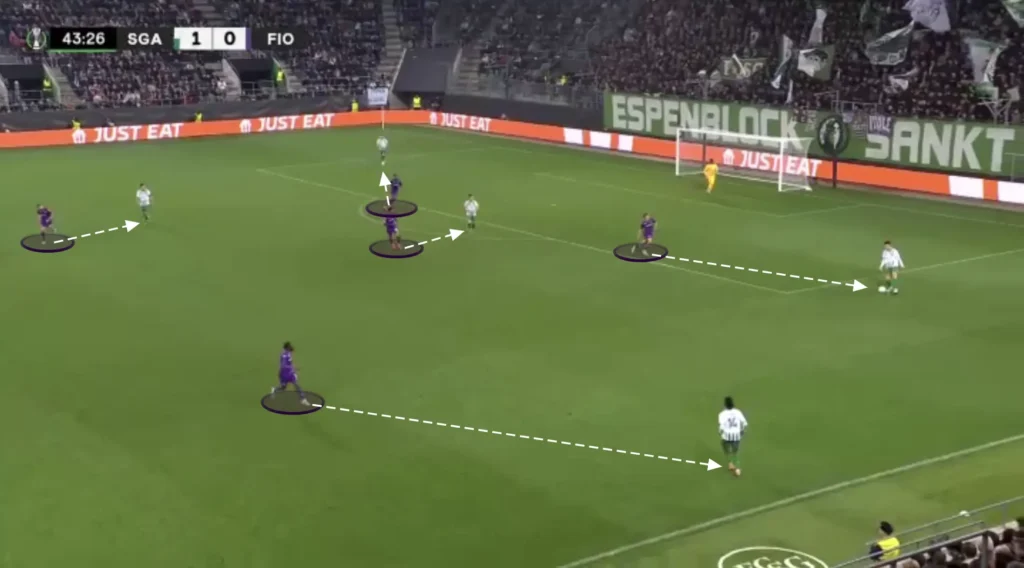
And lower down the pitch:
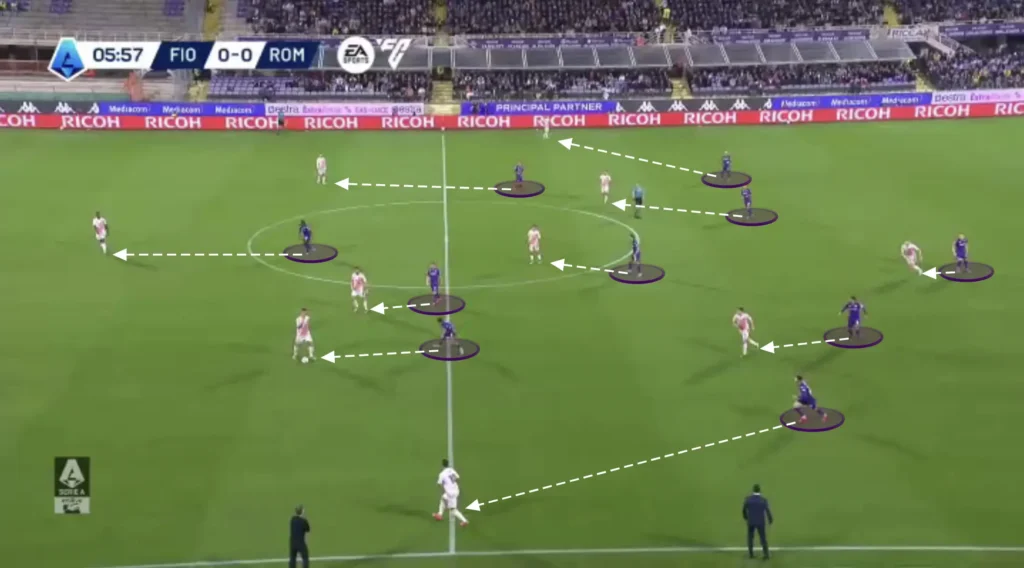
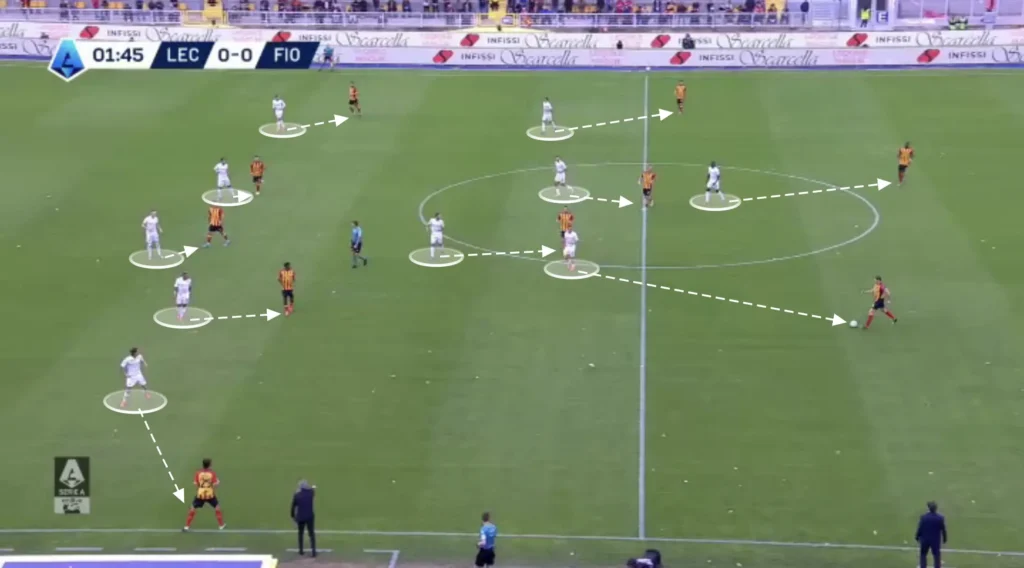
+1 at the Back
In some matches, rather than marking every opposition player, Fiorentina intentionally leaves one of the opposing center-backs unmarked and goes man-to-man on the rest of the players. This strategy allows Fiorentina’s backline to maintain an additional defender, creating a slight numerical advantage at the back. The extra defender sits deeper, enabling Fiorentina to respond more effectively to runs or sudden shifts in attacking play, especially against teams that rely on quick attacking play or complex positional rotations.
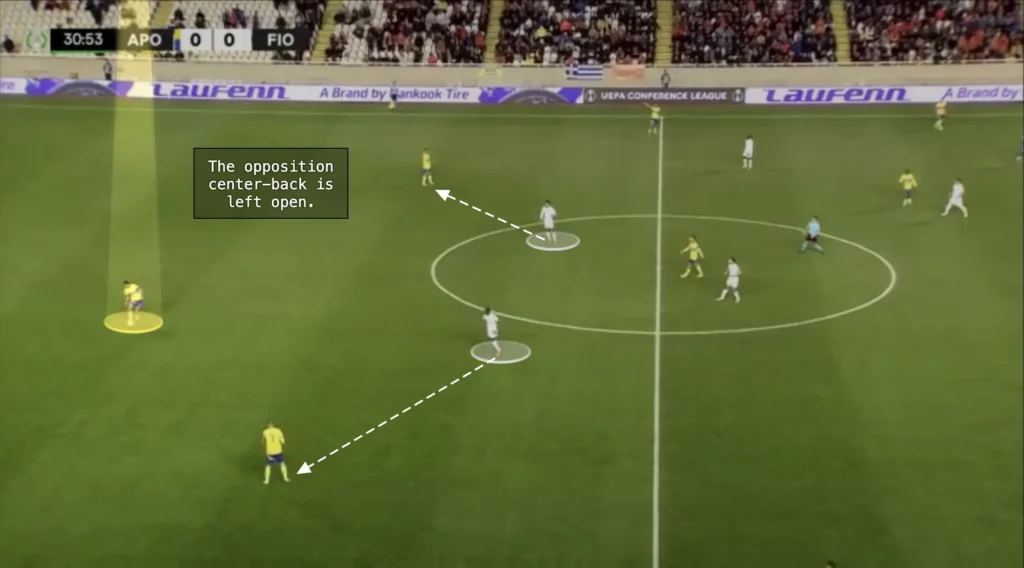
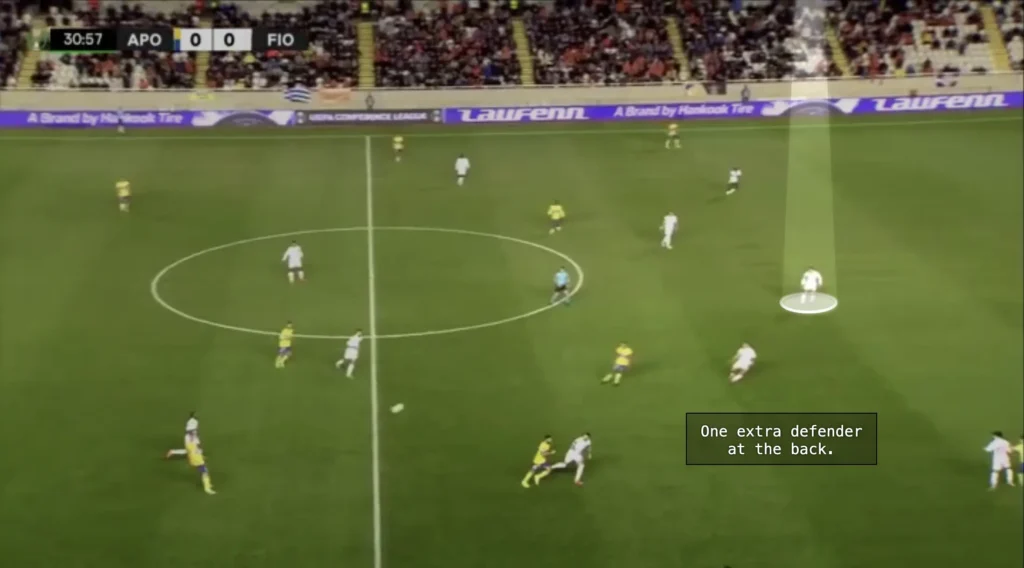
This adjustment demonstrates Palladino’s tactical adaptability. By tweaking their marking structure, Fiorentina can switch between a tighter man-marking system and a more reserved defensive approach, depending on the game’s demands.
Distance Marking
In a man-to-man system, it becomes crucial that the players know when to mark the opponent they are responsible for and when not to. The Fiorentina players will always have an opposition player for whom they are accountable. However, they will never be closer to them than they need to be. If an opponent, for example, is very far from the ball, the Fiorentina player marking him does not need to be as close to him. He can instead come in and help create numerical superiorities in the center, decreasing the risk of dangerous 1v1 situations.
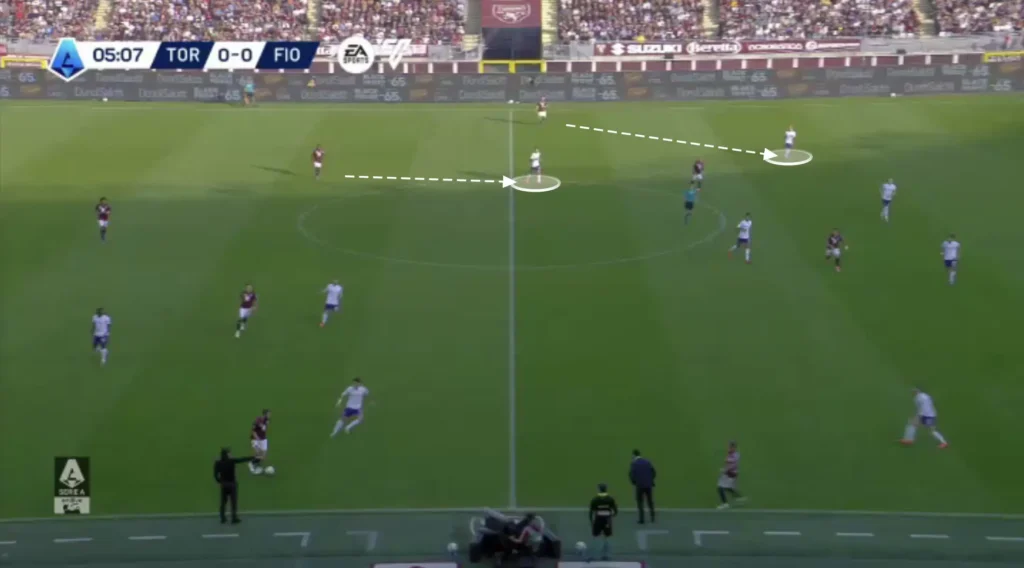
A rule of thumb for the players is that the closer you are to the ball, the closer you need to be to your opponent. The further away you are from the ball, the further away you can be from your opponent.
Squeezing the Pitch
Additionally, Palladino wants his team to squeeze the pitch when defending. This means constantly pushing the team up as much as possible. Every time the opponent plays a slow, sideways pass or a back pass, the Fiorentina player that is marking the opposition player who receives the ball pushes up. When this happens, the rest of the team has to follow to stay compact. When the next pass comes, the next player pushes up, forcing the opponent back even more.
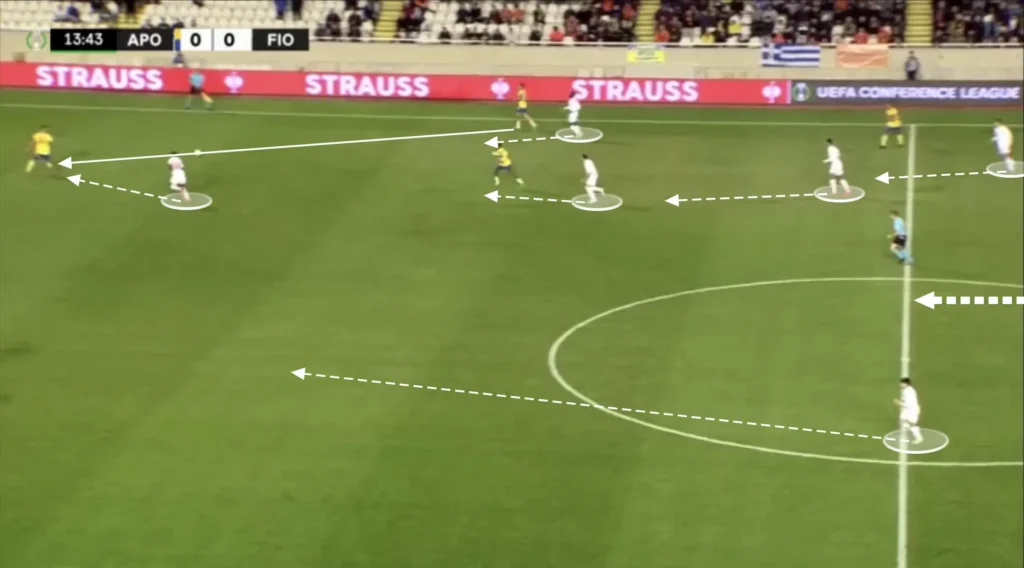
This approach keeps opponents under constant pressure, making it difficult for them to build rhythm or find space between the lines. It also pushes the opponent further away from the Fiorentina goal, making it harder to create chances.
Issues with the Man-to-Man Press
Pressing in an aggressive man-to-man system comes with significant risks. While it can force mistakes and win the ball high up the pitch, it leaves large spaces vulnerable to exploitation. If just one player is beaten or fails to track their man, the opposition can easily bypass the press, creating numerical advantages in key areas. This system requires perfect coordination and constant high energy; if fatigue sets in or communication breaks down, it can leave the defensive line exposed.
Additionally, aggressive pressing opens up gaps in wide areas or behind the defense, making the team susceptible to early through-balls. If an opposition midfielder gets time on the ball, he can find an attacker making a run in behind the backline, creating all sorts of issues for the Fiorentina defenders.
Build-up
Fiorentina’s build-up play under Raffaele Palladino is marked by a highly fluid 1-4-2-1-3 structure, which offers flexibility and control in progressing the ball up the pitch.
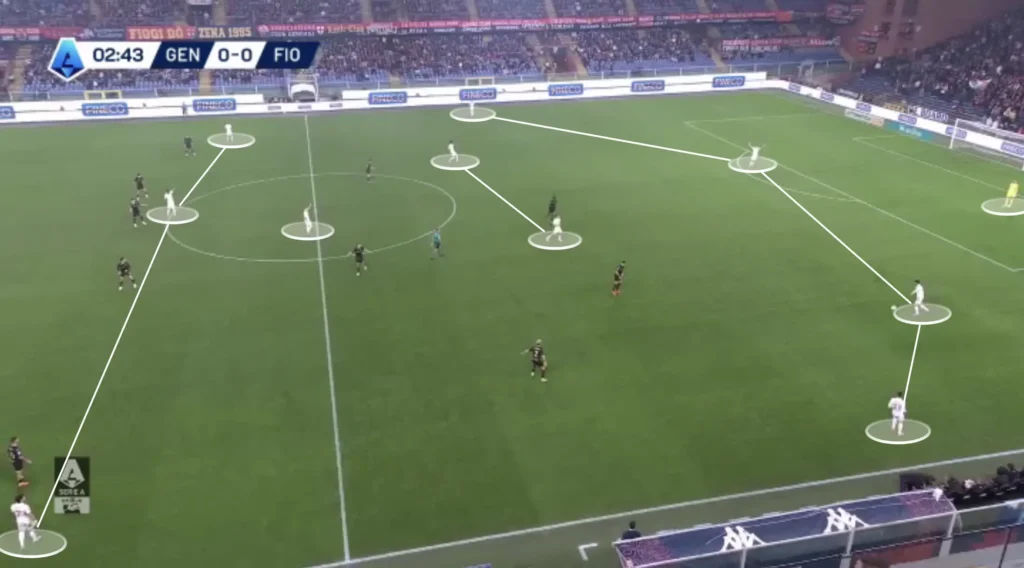
In this setup, the back four provides a solid foundation, but the shape quickly adapts based on the positioning of the midfield and attacking lines. The two holding midfielders act as pivots, frequently dropping deep to create numerical advantages in the first phase, while the number-ten finds pockets of space between the lines to link up play. The wingers in the front three maintain width, stretching the opposition’s defense and creating lanes for forward passes, while the central striker stays ready to receive through balls or exploit space behind the defense. This fluidity not only helps Fiorentina evade high presses but also enables them to maintain possession and initiate attacks in varied ways, making their build-up challenging to disrupt.
Fiorentina have also used the 1-4-2-4 formation in the build-up, still keeping the same principles and fluidity.
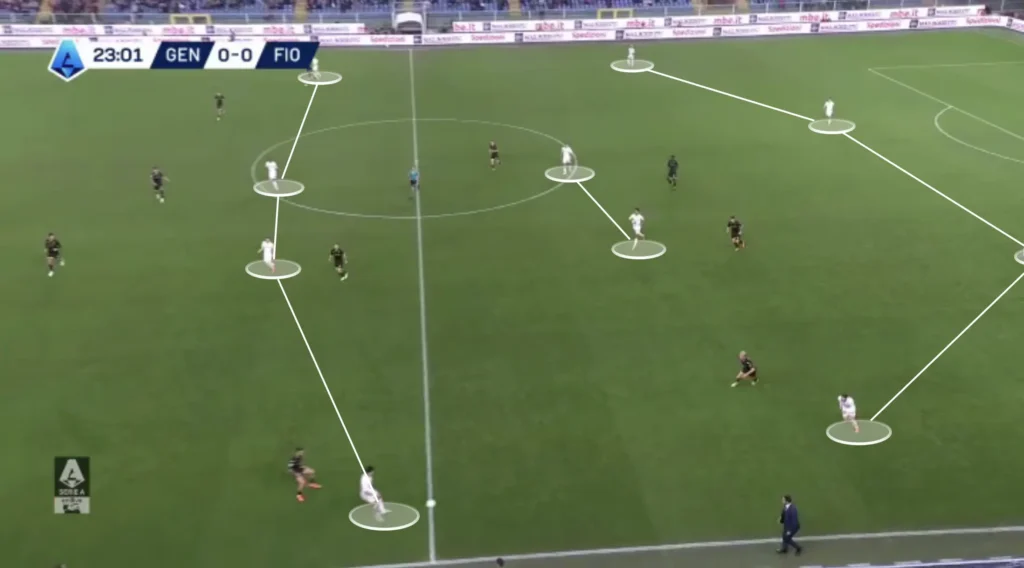
Rotations and Fluidity
The Fiorentina players constantly rotate during the build-up. The team adopts a dynamic approach, shifting between formations to create numerical advantages and exploit spaces. Palladino’s focus is always to get the players into their best positions, where they can make the most out of their individual skills. He emphasizes versatility, with players interchanging positions seamlessly to maintain possession and disrupt the opposition’s defensive structure. This flexibility creates numerical superiorities in different areas, allowing Fiorentina to bypass the opposition’s press while maintaining control.
Their most common rotation is to drop one of the holding midfielders into the backline. This shift creates a back three, allowing them to maintain defensive stability while gaining more control in possession.
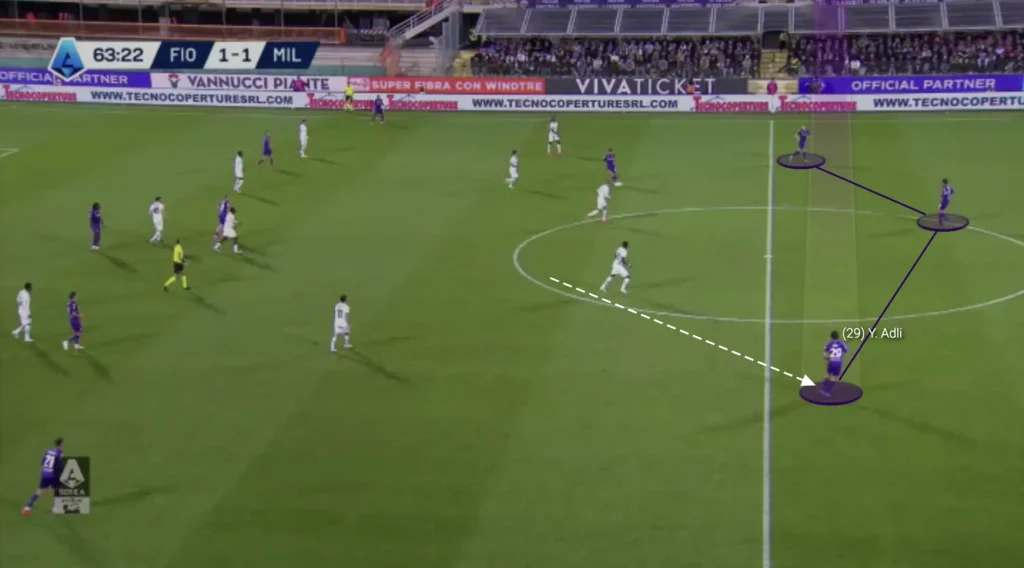
By doing this, Fiorentina not only widen the field but also open up different angles for passing, making it easier to beat the opposition’s press.
Inverting Fullbacks
Fiorentina frequently uses an interesting tactic in their build-up, where they invert one of their fullbacks up into the midfield.
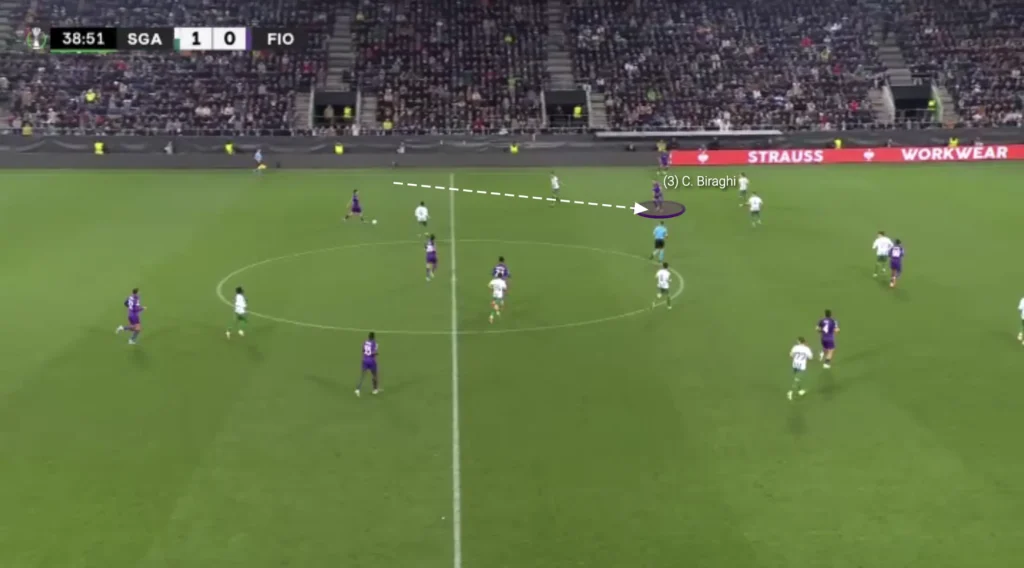
This approach, often seen in Palladino’s setup, adds both stability and versatility. By pushing one fullback up, Fiorentina create an extra midfield presence, allowing them to dominate central spaces and overload the opposition’s midfield.
Additionally, when a fullback inverts, the opposition winger usually comes inside to cover the run, which opens the passing lane from Fiorentina’s midfield to the winger. A holding midfielder can play the ball to the winger, who can attack the opposition fullback and combine with a central midfielder to create a 2v1 situation.
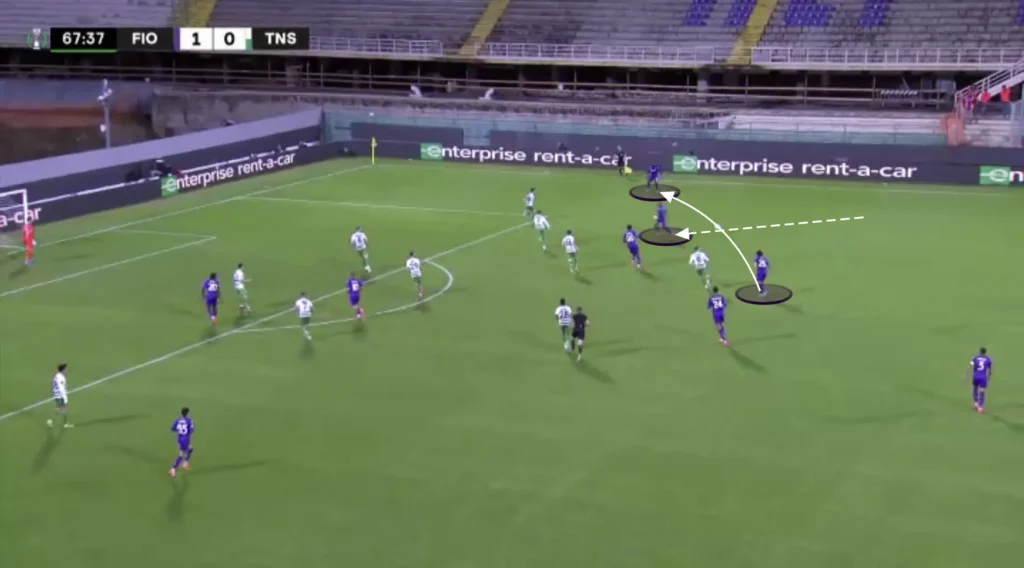
High Backline
Another massive aspect of Palladino’s high build-up is to have the defenders high up and close to the center. This helps in the counterpress because they get closer to the midfield. Having more players close to the center who can win the ball back makes it difficult for the opposition to do anything when they win possession. Furthermore, the high backline shortens the distance between players, shortening the time and length of the passes and preventing the opposition from pushing up their defense.
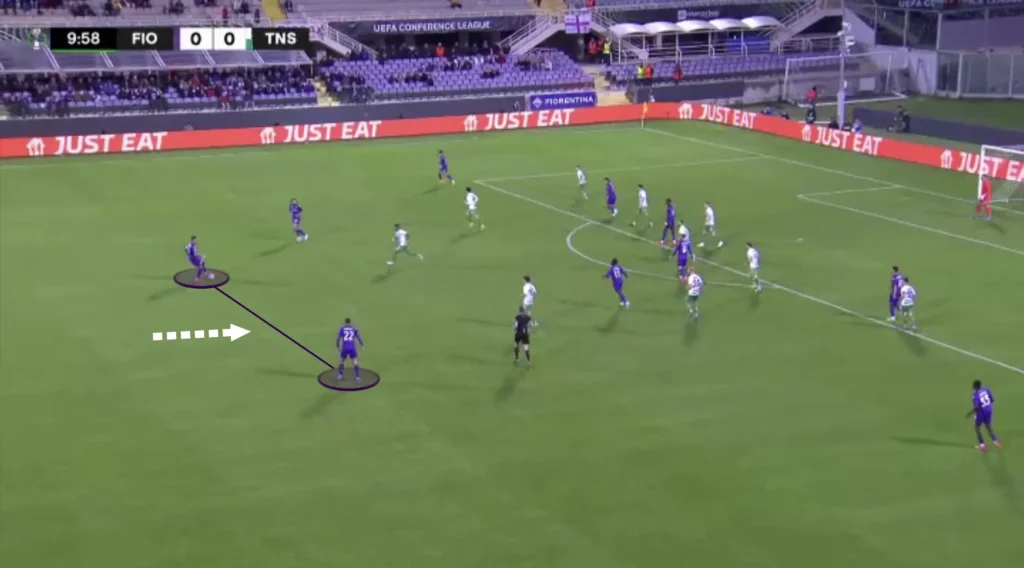
Follow Pressure
A common tool that the Fiorentina players use to play past the opposition in the build-up is to follow the pressure. This means running into the space that a pressing player is leaving behind. When an opposition winger, for example, pushes up to press a Fiorentina defender, space opens up behind the winger. A Fiorentina midfielder will often run into this space, giving the defender the option to pass him the ball on the outside of the opposition winger.
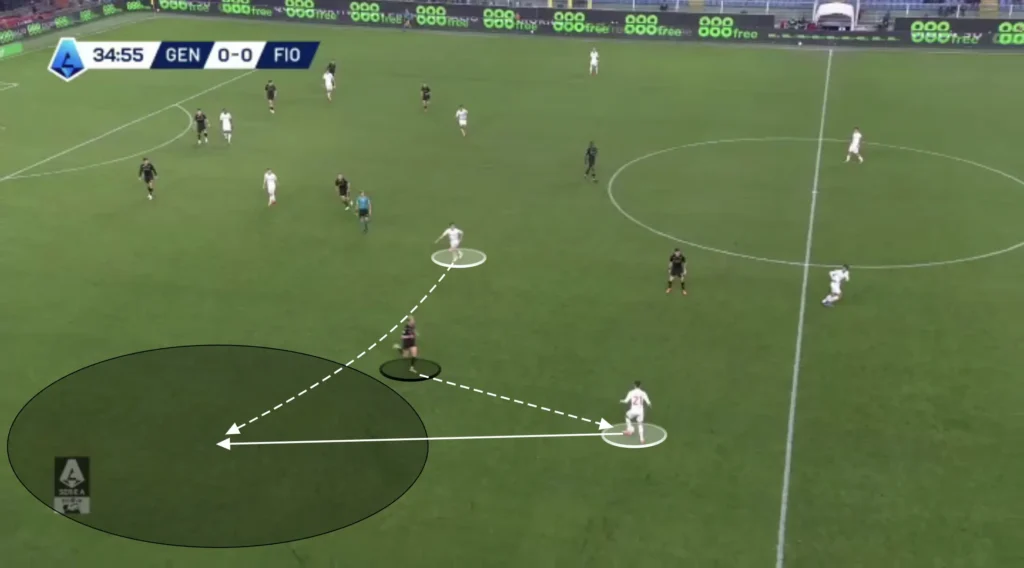

Other opposition players will rarely follow the midfielder into this space, which allows him to receive the ball, turn, and progress the ball up the pitch.
Finding the Pockets
Further up the pitch, Palladino’s players always try to find the midfielders(mainly the number-ten) in the pockets. These “pockets” refer to the spaces between the opposition’s defensive and midfield lines, where the midfielders can receive the ball in more advanced positions.
By positioning themselves intelligently in these pockets, the Fiorentina midfielders can turn quickly and face the opposition’s goal, creating opportunities for through balls, driving runs, or direct shots. This positioning forces the opposition to make difficult decisions. If an opposition defender steps up and closes down the Fiorentina player, he potentially leaves space behind. However, if he stays back, he allows the midfielder time on the ball.
The Fiorentina defenders and holding midfielders will look for straight passes, breaking the opposition lines and finding the more attacking midfielders in these spaces, who can turn and drive at the defense.
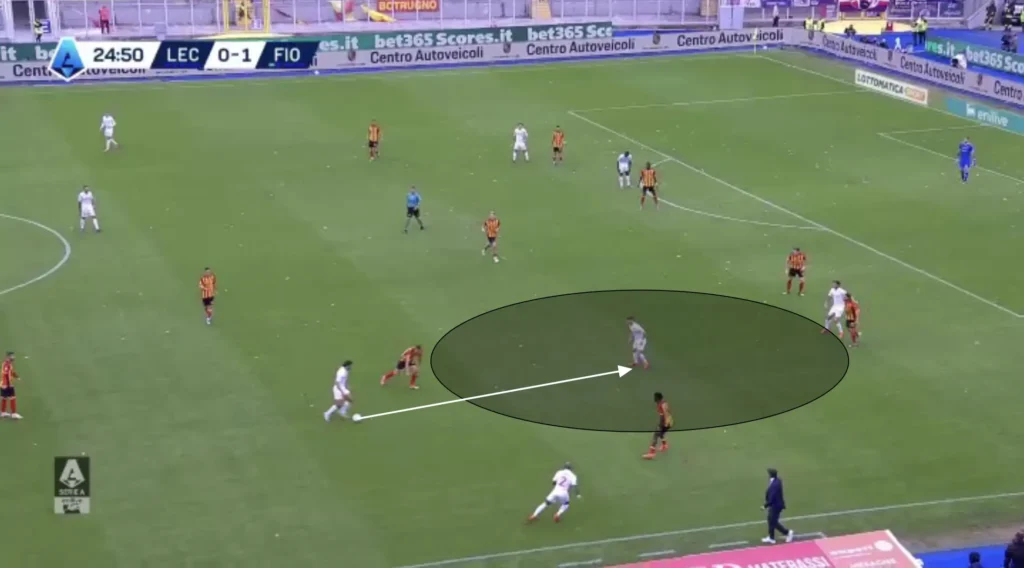
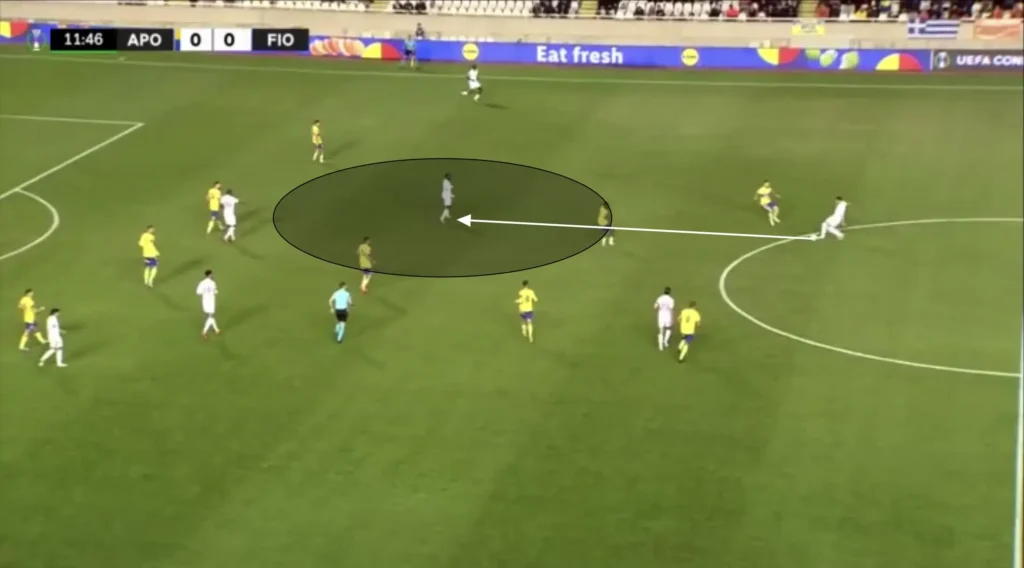
Finding these pockets is crucial for maintaining fluidity in attack and ensuring that the team can progress the ball effectively through the middle of the pitch.
Numerical Advantages Against the Opposition’s Defense
A massive aspect of Fiorentina’s high build-up is their ability to create numerical advantages against the opposition’s defensive line. Many players often push high up the pitch, essentially adding extra bodies to Fiorentina’s forward line, forcing the opposition’s backline into difficult situations. This movement increases the number of attackers, and as a result, Fiorentina can overload the defense, creating gaps for their attackers to exploit.
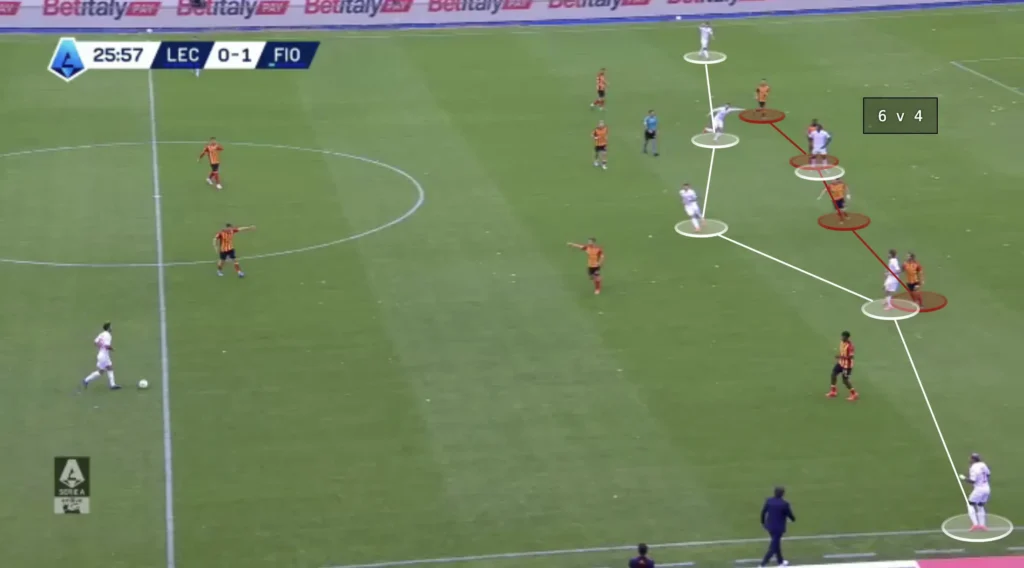
Palladino’s players mainly exploit this overload by creating 2v1 situations against the opposition fullback. These 2v1 situations will usually be found when Fiorentina use quick switches of play. When the ball is on one side, the weak-side fullback becomes vulnerable to the switch of play due to the 1v2 against Fiorentina’s winger and attacking midfielder(usually an inverted fullback). The attacking midfielder will often make a run in behind, which the defending opposition fullback will follow. This opens the space out wide for Fiorentina’s winger to be found with a long ball.
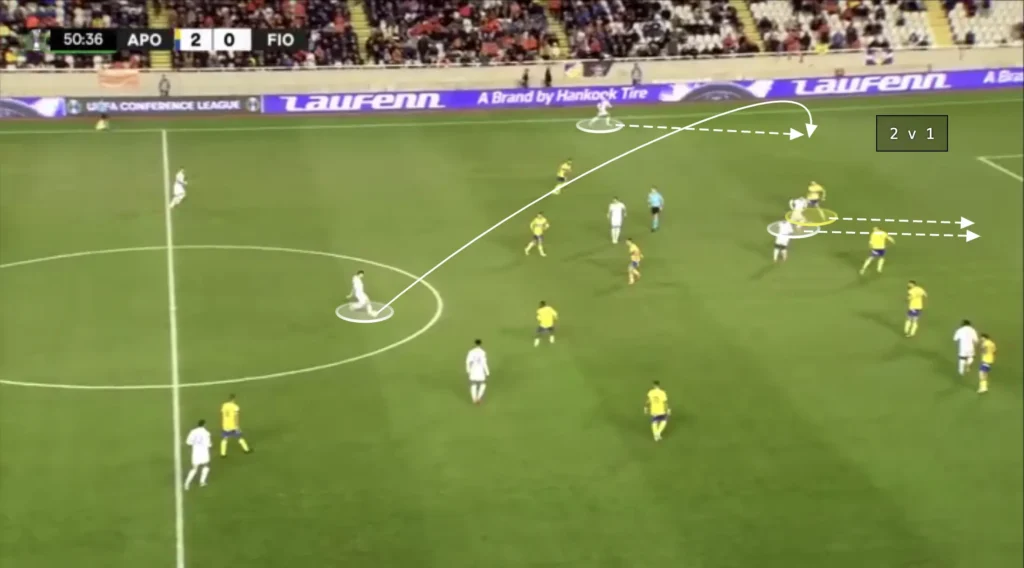
Palladino’s team often uses this to get the ball to the winger out wide, who can attack the opposition fullback and create 2v1 situations against him with a Fiorentina midfielder or fullback.
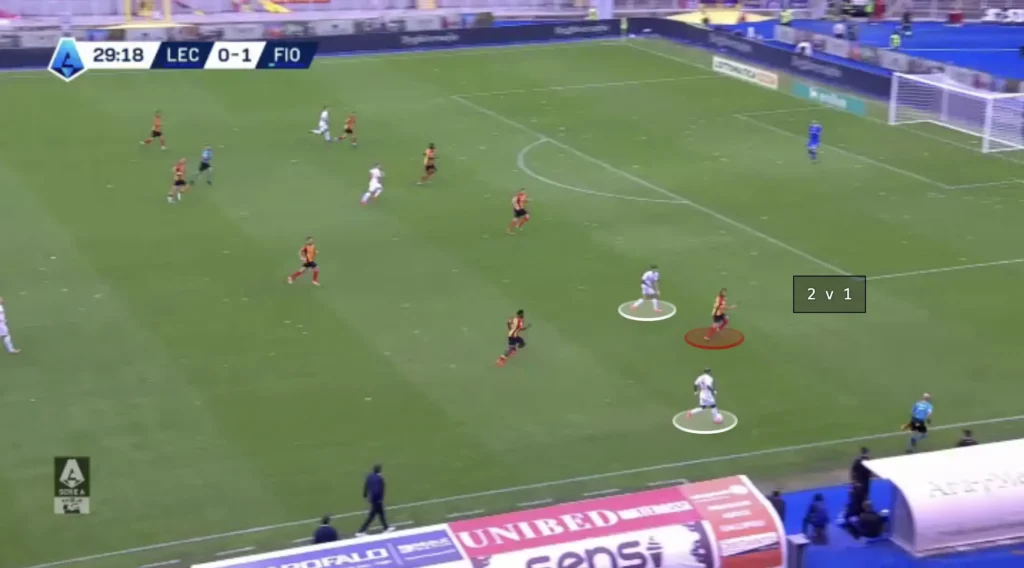
Final Third
Attacking the Half-Space
Palladino’s players usually look to create chances by attacking the space between the opposition center-back and fullback. They primarily do this from the wide areas with underlaps from the midfielders. When the Fiorentina winger receives the ball out wide, he will attract the opposition fullback. This opens the space between the opposition fullback and center-back, which allows a Fiorentina midfielder to make the underlapping run into this space. The ball can be played to the underlapping player, who can cross the ball into the box or attack his defender in a 1v1 situation.

Additionally, the fullback does not have to play the ball to the underlapping player. The run from the Fiorentina player will often drag away an opposition defensive midfielder, which opens the space inside. The winger can take the ball inside and shoot or find a pass to a free player in front of the backline.
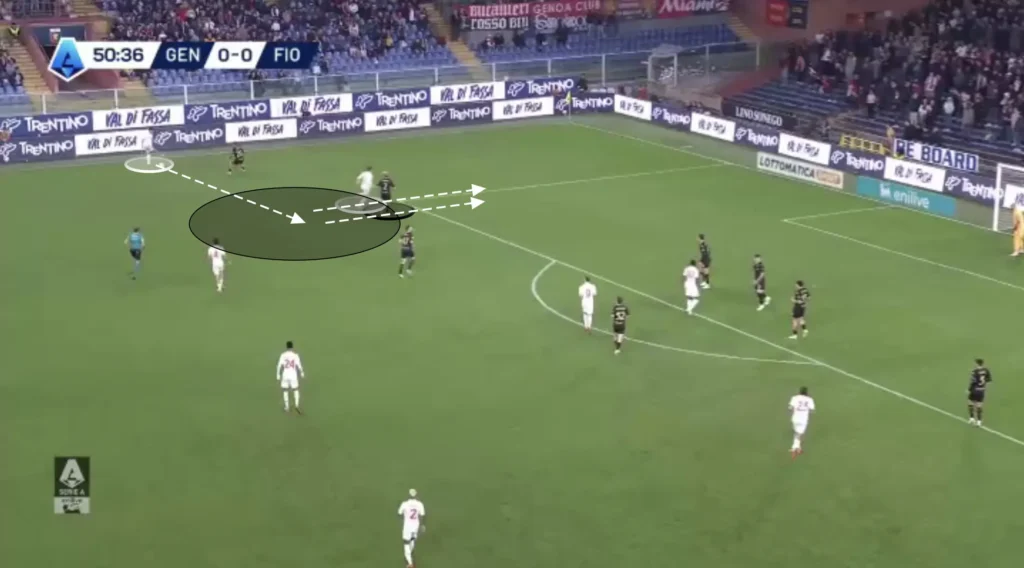
Fiorentina will also exploit this gap between the opposition fullback and center-back with through-balls to well-timed runs from the midfielders. These incisive movements add an extra layer to Fiorentina’s offense, making it harder for defenses to stay organized.
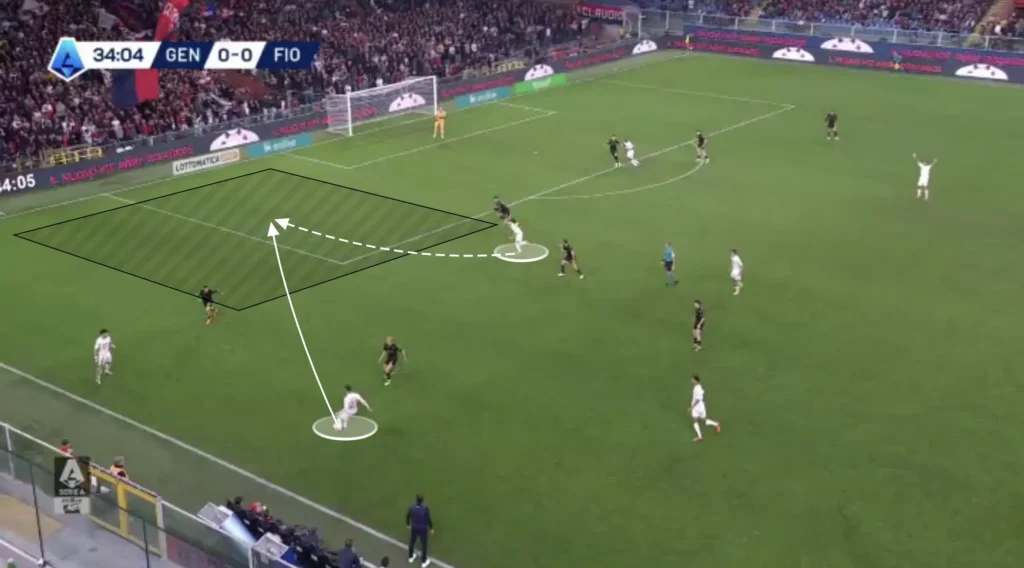
Overlaps
Fiorentina have also used overlaps as a key tactic to create goalscoring opportunities under Palladino. This involves the fullbacks making forward runs to get around their winger, providing an extra attacking option on the flanks. By doing so, they create a 2v1 situation with the winger against the opposition fullback, which could be used to beat the fullback and create crossing opportunities.
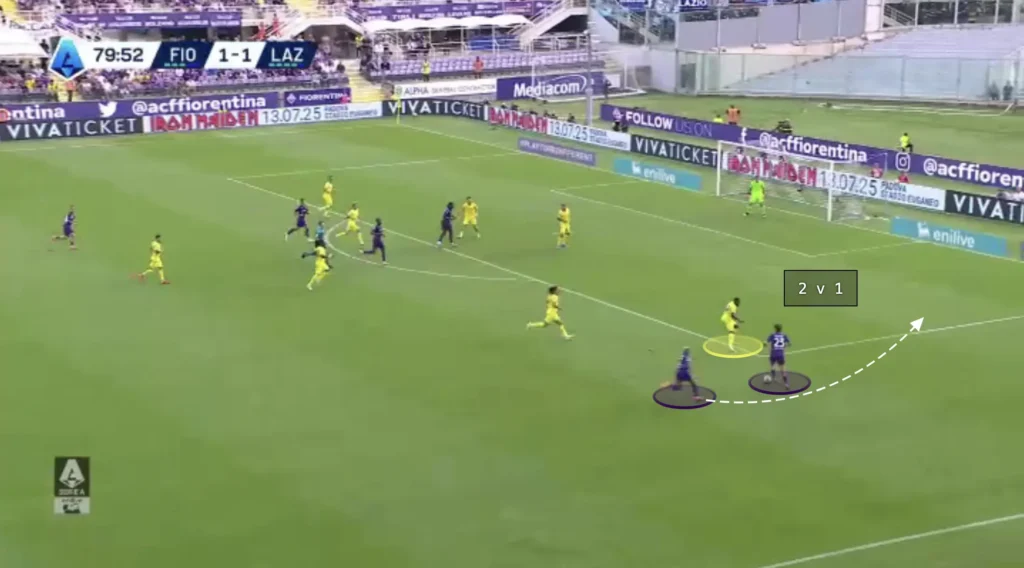
Fiorentina’s wingers often initiate the play by attracting the opposition fullback, leaving space for an overlapping fullback to exploit. The overlap forces the defending fullback to make difficult decisions—either stick with the winger or follow the overlapping fullback. If the opposition fullback drops to cover the overlapping run, the winger could cut inside and take a shot or combine with a midfielder. If the fullback covers the center, the ball can easily be played to the overlapping player, creating a crossing opportunity.
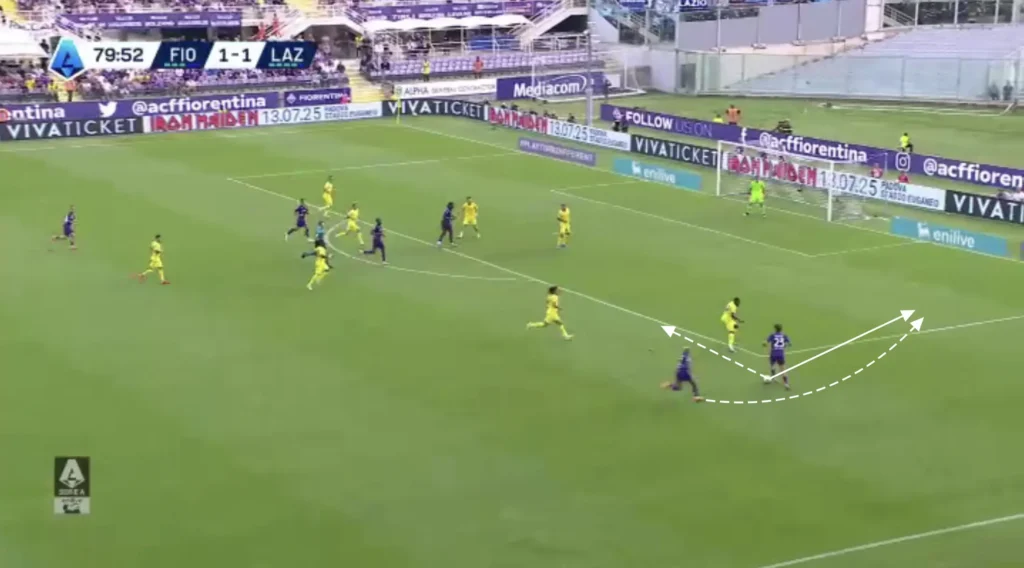
Many Players in the Box
Palladino consistently emphasizes getting multiple players into the box, creating a chaotic environment for the opposition defenders, and increasing their chances of scoring. The attackers, midfielders, and even fullbacks look to make aggressive runs into the box when the ball is in the final third, often getting four or five players into these areas to create overloads.

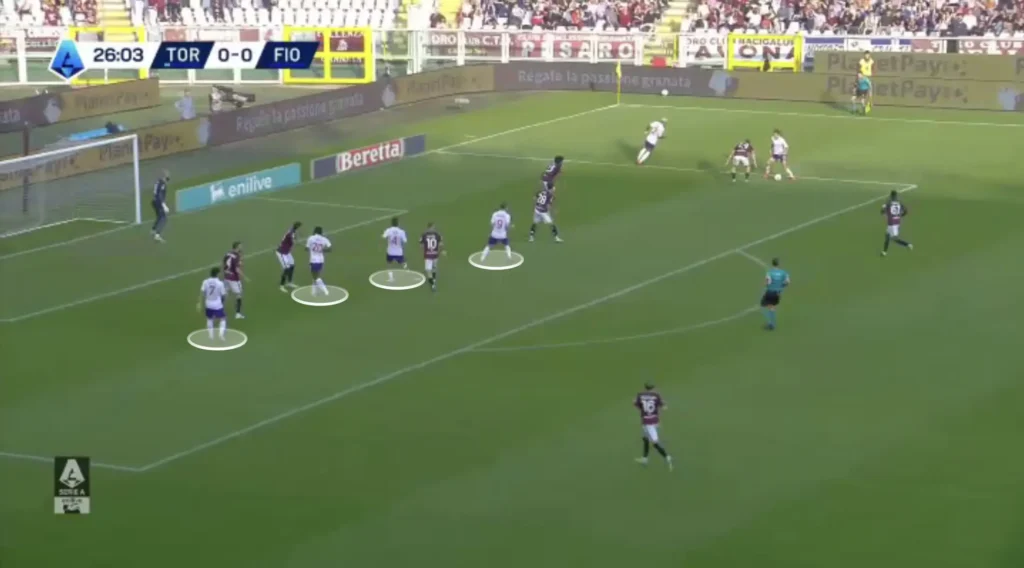
The numerical advantages in the box increase the chances of connecting with the cross, as more players present multiple targets for the crosser, making it harder for defenders to mark everyone effectively. Additionally, having multiple players in the box provides options for different types of finishes, whether it’s a header, volley, or a quick tap-in. It also allows for better positioning to react to second balls or rebounds, increasing the likelihood of capitalizing on any defensive errors.
Palladino also positions many players outside the box, ready for the second balls and cut-backs. Fiorentina will create many crossing opportunities, which pushes down the opposition’s defense and opens the space in front of the opposition’s backline. The central midfielders can collect any loose balls or be found directly in these spaces with cut-backs, and from there, they can shoot or combine with an attacker to create goalscoring opportunities.
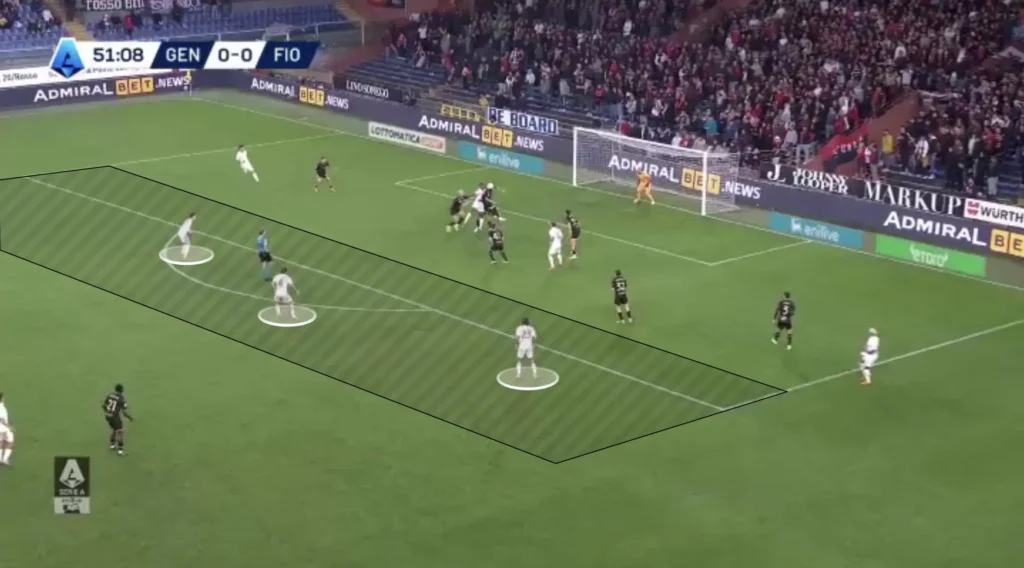
Transitions
Defensive Transitions
Fiorentina are great in defensive transitions. In possession, they always have many players high up and close to the ball, which creates good conditions for counterpressing. Many players close to the ball after losing possession means that many players can work towards regaining possession. Palladino’s players are also very aggressive in the first seconds after losing the ball. The four or five players closest will immediately jump on the opposition player with the ball and close the distance to cut off any passing lanes. This approach disrupts the opponent’s transition from defense to attack, forcing errors and creating opportunities to regain control in dangerous areas.
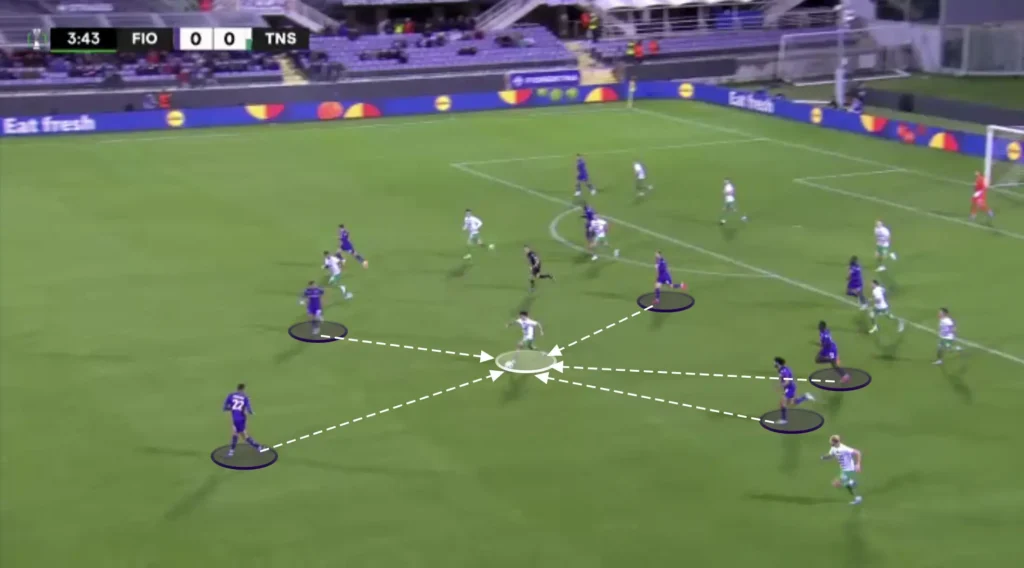
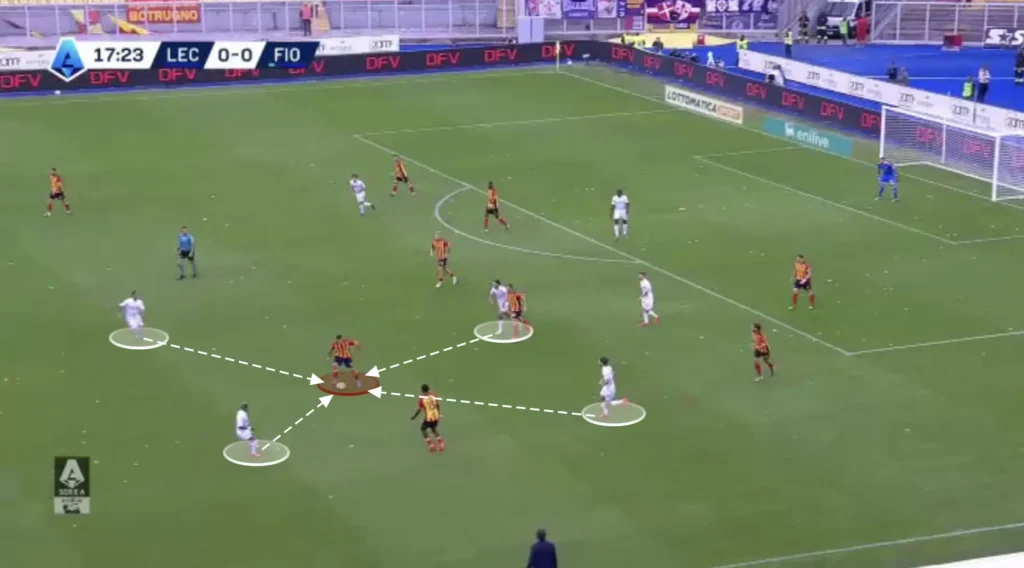
Counterpressing like this keeps Fiorentina on the front foot, allowing them to dominate possession and create more scoring opportunities. However, it requires exceptional fitness, tactical discipline, and teamwork.
Offensive Transitions
Palladino also wants his team to counterattack in their offensive transitions. When they win back possession, Fiorentina’s players immediately shift into attack mode, looking to exploit any space left by opponents. Their midfielders often initiate the counterattacks with quick, vertical passes to the forwards or wide players, who are already positioned to make penetrating runs. This rapid transition is often supported by overlapping fullbacks, providing width and stretching the opposition’s defense. With these quick movements, the Fiorentina players frequently catch teams off guard, creating high-quality chances before the opponent can regroup defensively.
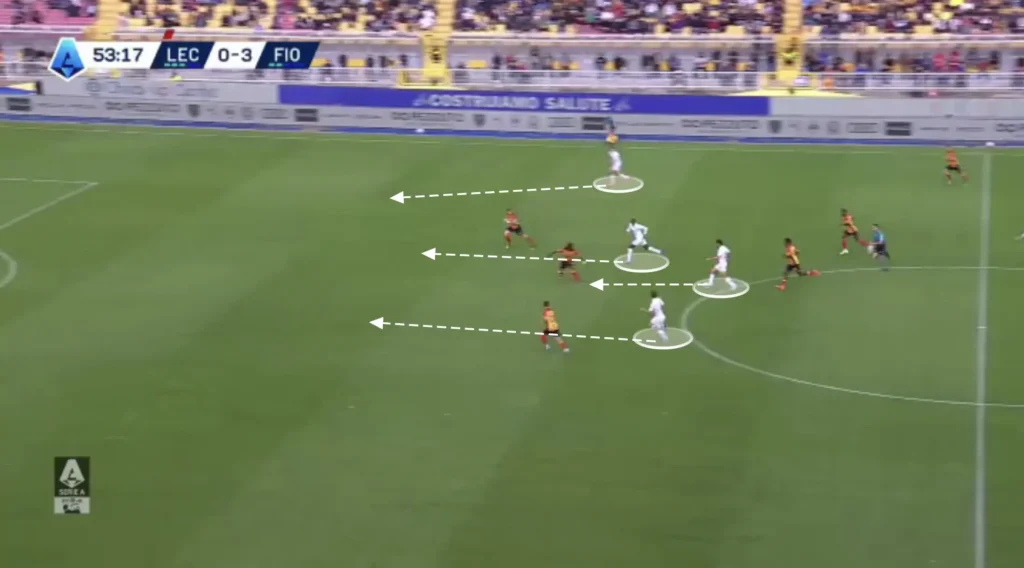
Additionally, the Fiorentina players are great at finding open spaces in the counterattacks. Instead of playing the ball straight forward where opposition defenders may still be positioned, they play a diagonal pass, allowing the team to bypass pressure and shift the play into open areas. From these areas, the Fiorentina attackers can take the ball forward and quickly get past the opposition to create a goalscoring opportunity.
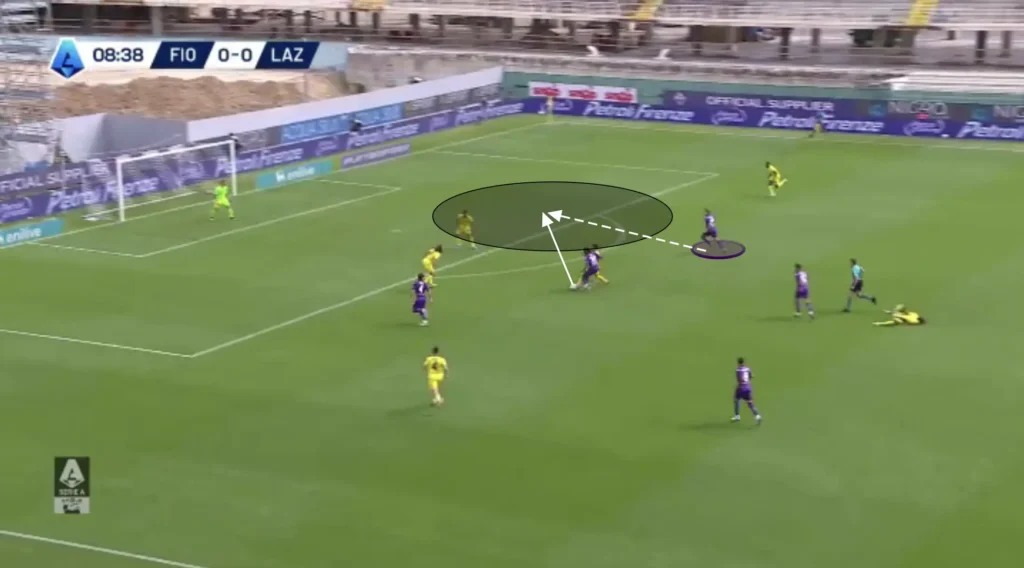
Fiorentina’s aggressiveness also means they have many players high up when defending, which enables them to incorporate more players into the counterattacks.
Final Thoughts
In conclusion, Raffaele Palladino’s approach at ACF Fiorentina demonstrates a tactical vision that balances structure with creativity, allowing players to express themselves within a disciplined system. His emphasis on fluid formations, quick transitions, and strategic pressing reflects a modern style of play that adapts well to different phases of the game.
Palladino’s Fiorentina combines defensive resilience with a dynamic attack, creating a team that is not only tough to break down but also quick to exploit opportunities. This analysis highlights how his tactics contribute to a well-rounded squad capable of challenging opponents with both stability and flair. As Fiorentina continues to develop under Palladino, fans can look forward to a team that embodies both tactical intelligence and an exciting, forward-thinking style of football.

I love those detailed analysis u do eg following the press or the players looking to occupy pockets. Sorry about my English it’s not my first language I’m still learning it